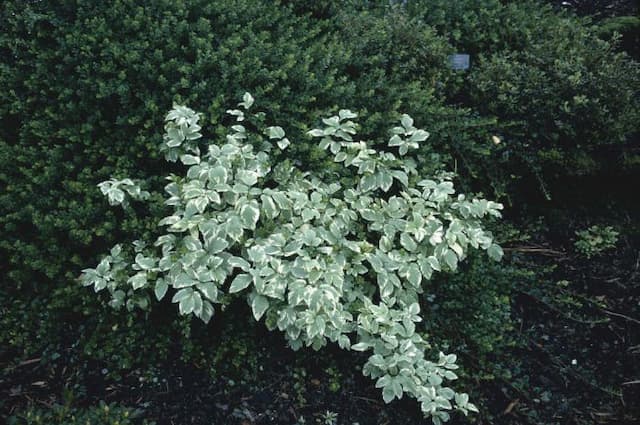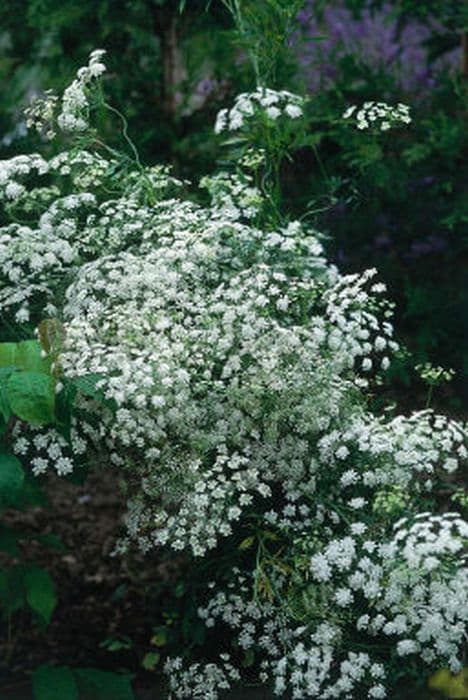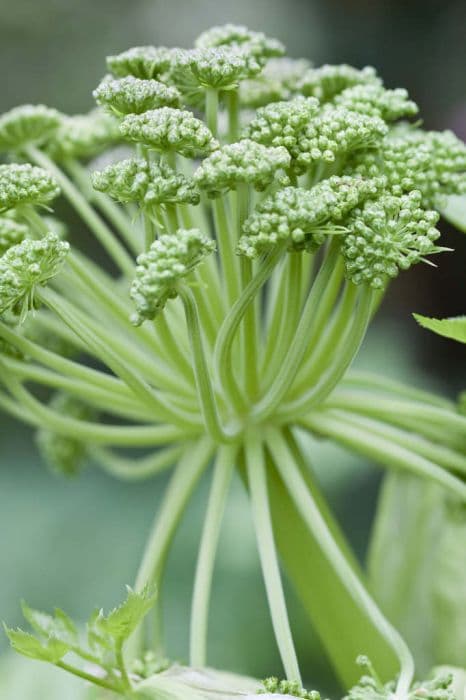Agave-leaved sea holly Eryngium agavifolium

ABOUT
Eryngium agavifolium, commonly known as Agave-leaved Sea Holly, is a striking perennial plant cherished for its bold and architectural appearance. The most distinctive feature of this plant is its foliage, which bears a remarkable resemblance to that of agave plants. The leaves are long, stiff, and pointed, forming a rosette at the base of the plant. Each leaf has serrated edges that resemble the teeth of a saw, giving the plant an almost formidable quality. The color of the leaves ranges from a deep green to a bluish-green hue, contributing to the Agave-leaved Sea Holly's eye-catching appearance. Above the rosette of leaves, the plant produces tall, branching stems that bear clusters of small, thistle-like flowers. The blossoms are typically a metallic blue or greenish-blue color and are encased in spiny bracts, which add to the unique texture of the plant. Agave-leaved Sea Holly's overall aesthetic is one of rugged beauty, with its spiky silhouette and resilient-looking foliage evoking the feeling of a desert landscape. Despite its tough exterior, it comes alive when in bloom, attracting pollinators with its vibrant inflorescences. Its appearance makes it a popular choice for gardeners looking to introduce an element of drama and structural interest into their garden designs.
About this plant
 Names
NamesFamily
Apiaceae
Synonyms
Agave-leaved Sea Holly, Agave-leaved Eryngo
Common names
Eryngium paniculatum, Eryngium proteiflorum
 Toxicity
ToxicityTo humans
Eryngium agavifolium, commonly known as agave-leaved sea holly, is not widely recognized as a toxic plant to humans. There is limited information available on the toxicity of this specific species. However, if any part of the plant is ingested, it is always wise to observe for any symptoms of discomfort or allergic reactions due to individual sensitivities and to seek medical advice if symptoms appear or if there are concerns about potential poisoning.
To pets
Agave-leaved sea holly is not commonly known to be toxic to pets either. Like with humans, there is little information suggesting significant toxicity to animals. Nevertheless, ingestion of plant material by pets may cause gastrointestinal upset or potential allergic reactions, so monitoring for signs of distress and consulting a veterinarian is advisable if a pet consumes any part of the plant.
 Characteristics
CharacteristicsLife cycle
Perennials
Foliage type
Evergreen
Color of leaves
Green
Flower color
Green
Height
2 feet (60 cm)
Spread
2 feet (60 cm)
Plant type
Herb
Hardiness zones
7
Native area
Argentina
Benefits
 General Benefits
General Benefits- Decorative Appeal: Eryngium agavifolium, commonly known as Agave-leaved Sea Holly, has striking sword-shaped leaves and greenish-white flower heads that add a unique architectural element to gardens and landscapes.
- Drought Tolerance: This plant is highly resistant to drought, making it an ideal choice for xeriscaping or low-water-use gardens.
- Pollinator Attraction: Agave-leaved Sea Holly attracts bees, butterflies, and other beneficial insects, supporting biodiversity and pollination.
- Low Maintenance: Eryngium agavifolium requires minimal care once established, making it suitable for gardeners looking for low-maintenance options.
- Deer and Rabbit Resistance: The plant's spiny texture and foliage deter deer and rabbits, protecting it from grazing and making it a good choice for wildlife-prone areas.
- Long-Lasting Cut Flowers: The flowers of Agave-leaved Sea Holly are long-lasting when cut and are often used in floral arrangements, adding to their ornamental value.
- Soil Adaptability: It can adapt to a variety of soil conditions, though it prefers well-draining soil, making it a versatile plant in garden design.
- Seasonal Interest: The plant provides visual interest throughout the growing season, with its foliage being evergreen in milder climates, contributing to year-round garden appeal.
 Medical Properties
Medical PropertiesThis plant is not used for medical purposes.
 Air-purifying Qualities
Air-purifying QualitiesThis plant is not specifically known for air purifying qualities.
 Other Uses
Other Uses- Eryngium agavifolium, commonly known as agave-leaved sea holly, can be used as a unique addition to floral arrangements due to its striking, thistle-like flower heads which add texture and a touch of silver-blue to bouquets.
- The plant's long-lasting flowers are suitable for drying and can be used in crafting dried flower arrangements or potpourri, holding their shape and color well over time.
- The distinctive foliage of agave-leaved sea holly is sometimes used in landscape design to provide a contrast to softer, more traditionally shaped leaves, adding an architectural element to gardens.
- In garden ponds or water features, agave-leaved sea holly can be planted in the margins to contribute to an aesthetically varied and structurally interesting waterside planting scheme.
- The plant can serve as a living fence or border when planted in a row due to its spiky leaves and overall deterrent appearance, thus providing a natural barrier against small animals or foot traffic.
- Agave-leaved sea holly is often planted to attract beneficial insects like bees and butterflies, contributing to the pollinator-friendly environment in gardens or farms.
- This plant's robust nature allows it to be used in coastal gardens where it can tolerate the salty air and windy conditions that many other plants cannot withstand.
- Because of its tolerance for poor soils, agave-leaved sea holly can be used in reclamation projects to help stabilize and cover disturbed ground in low-fertility areas.
- As an ornamental plant in xeriscaping, agave-leaved sea holly is valued for its ability to thrive with minimal watering, thereby conserving water resources in arid regions or during droughts.
- The silver-blue hue of the plant makes it a popular option for moon gardens, which are designed to be enjoyed in the evening and rely on plants that reflect moonlight or have a luminescent quality.
Interesting Facts
 Feng Shui
Feng ShuiAgave-leaf sea holly is not used in Feng Shui practice.
 Zodiac Sign Compitability
Zodiac Sign CompitabilityAgave-leaf sea holly is not used in astrology practice.
 Plant Symbolism
Plant Symbolism- Determination: Eryngium agavifolium, also known as Agave-leaved Sea Holly, features hard, spiny leaves that convey a message of resilience and unyielding strength, symbolizing an individual’s determination to push through challenges.
- Protection: The thorn-like appearance of Agave-leaved Sea Holly's foliage denotes protection and defense against negative forces, similar to the way physical spines protect the plant.
- Independence: The robust and self-sufficient nature of this plant, capable of thriving in poor soils, highlights qualities of independence and self-reliance.
- Attractiveness: With its striking and unique appearance, the Agave-leaved Sea Holly can symbolize an exotic attractiveness or a magnetic personality that stands out in a crowd.
- Unconventional beauty: Agave-leaved Sea Holly isn't conventionally pretty, but its distinctive look can symbolize a beauty that is unique and not bound by traditional standards.
 Water
WaterAgave-leaved sea holly, or Eryngium agavifolium, thrives in dry to medium moisture, well-drained soils. It should be watered deeply but infrequently to mimic natural environmental conditions. During active growth in spring and summer, water about once a week, providing about 1 to 1.5 gallons of water per plant, depending on the temperature and humidity. Reduce watering in fall and winter to every two to three weeks, allowing the soil to dry out between waterings. Always avoid waterlogging as this can lead to root rot.
 Light
LightAgave-leaved sea holly prefers full sun to part shade. The best spot for this plant is an area where it can receive at least six to eight hours of direct sunlight daily. If it's planted in too much shade, flower production and the plant's overall vigor may be compromised.
 Temperature
TemperatureAgave-leaved sea holly can tolerate a wide range of temperatures, but it thrives best in conditions between 60°F to 80°F. It can survive minimum temperatures down to about 10°F to 15°F, making it suitable for USDA hardiness zones 7 to 10. These plants are not suited for extreme heat; high temperatures over 90°F may stress them, so it's recommended to provide some afternoon shade in hotter regions.
 Pruning
PruningAgave-leaved sea holly should be pruned to remove spent flower heads and to maintain a tidy appearance; this can encourage additional blooming. Prune the faded blooms in late summer or early fall, cutting the stems back to the base of the plant. Major pruning is not generally required, but if needed for size control or rejuvenation, it should be done in early spring.
 Cleaning
CleaningAs needed
 Soil
SoilAgave-leaved sea holly (Eryngium agavifolium) thrives in well-draining, gritty soil; a mix of sand, gravel, and loam is ideal. Add organic matter sparingly. Aim for a soil pH close to neutral, between 6.0 and 7.0.
 Repotting
RepottingAgave-leaved sea holly (Eryngium agavifolium) is typically a slow grower and does not need frequent repotting—once every 3 to 4 years is adequate unless the plant outgrows its pot sooner.
 Humidity & Misting
Humidity & MistingAgave-leaved sea holly (Eryngium agavifolium) tolerates a wide range of humidity levels but prefers moderate conditions; avoid overly humid environments to prevent rot.
 Suitable locations
Suitable locationsIndoor
Place in bright light, avoid overwatering for indoor Agave-leaved sea holly.
Outdoor
Full sun and well-drained soil for outdoor Agave-leaved sea holly.
Hardiness zone
7-11 USDA
 Life cycle
Life cycleEryngium agavifolium, also known as Agave-leaved Sea Holly, begins its life cycle as a seed, which germinates in well-drained soil in spring after experiencing a period of cold stratification. Seedlings develop long strap-like leaves that form a rosette close to the ground. As the plant matures, it develops a deep taproot that lets it access water in dry conditions. During the blooming stage in summer, the plant produces tall, branched stems topped with thistle-like blue or greenish flower heads that attract pollinators. After pollination, seeds form and are dispersed by wind or wildlife, allowing the cycle to continue. In the autumn, the plant's above-ground parts die back, while the taproot survives underground to sprout new growth the following spring.
 Propogation
PropogationPropogation time
Spring to Summer
Eryngium agavifolium, commonly known as Agave-leaved Sea Holly, can be propagated most effectively through seed. To propagate by seed, it is generally best to sow them in late winter to early spring. The seeds should be placed on the surface of a well-drained seed starting mix, barely covered with soil, and kept moist. Germination can be erratic, so patience is necessary. Provide adequate light and a consistent temperature of around 70 degrees Fahrenheit (21 degrees Celsius) to enhance germination rates. Once seedlings have developed sufficiently and any risk of frost has passed, they can be transplanted outdoors to a location that offers full sun and well-drained soil.









